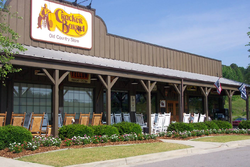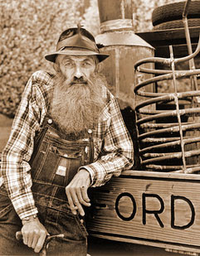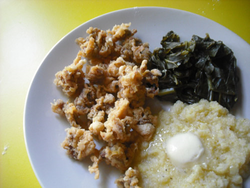Cracker Barrel

“Where there's an Interstate, there will always be a Cracker Barrel...”
Cracker Barrel is a Southern-themed family style restaurant that operates in North America, particularly in the United States. The chain has locations in 41 states with each business consisting of a restaurant and a country store that sells cheap junk that only your grandmother would want to buy. The nostalgia of the "stuff" these folks peddle easily offsets the extremely poor and toxic quality of the goods. The food itself is fairly decent considering it is processed southern comfort food.[1]
Cracker Barrels can be found along the fine Interstate Highways of America: if you see an exit or interchange, chances are there's a Cracker Barrel lurking around the corner waiting to ambush unsuspecting travelers.
Founding of the franchise
On a clear blue day in September 1869, Old Jedediah Smith of Lebanon, Tennessee thought to himself, "Gee wilikers, I could sure make a ton of money peddling our nasty Tennessee cuisine to unsuspecting Yankee travelers. Maybe I could also sell them cheap banjos or scented candles." Thus the first cracker Barrel was opened along what would one day become Interstate 40, selling food that was marketed as "wholesome" and "family-friendly." Jedidiah expanded his new company over the next few years and opened up new locations all across Tennessee. Most Tennesseans stayed far away from these Cracker Barrels as they understood quite clearly that the food served there was of an even lower quality than the already pitiful food they cooked and ate at home. Vacationers from the northern states however loved the novelty of the "wholesome southern cooking," that is, until they got reacquainted with their meal three hours later.
Cracker Barrel's food became the fixation of the early Progressive Movement after the food caused the deaths of three children in 1875. A brief movement arose to ban southern-style food all across the country. Cracker Barrel was soon facing financial difficulties and seemed to be on the brink of bankruptcy.
The Cracker Barrel Renaissance

After years of litigation in court and near bankruptcy in 1882, Cracker Barrel made a comeback. After the passing of Old Jedediah in 1883, his son, Godfrey Smith took over the business at age 23. What happened after that can only be described as an American legend in the food and restaurant industry. Godfrey realized that what plagued his company were the customers who were wise enough to complain about the sometimes poisonous food they were being served. To remedy this, Godfrey realized, all he had to do was make sure these customers would not be focused on the food, but rather on some other distraction. This is how the Cracker Barrel Old Country Store was born.
Building on his father's small banjo shops next to each restaurant, Godfrey was able to create an ingenious business model in which the only entrance and exit to the restaurant was through a spiced up gift-shop that sold cheap versions of actual useful products used on the farm. What was so revolutionary about this was that as the patrons entered the establishment looking for nourishment, they were greeted with a wondrous display of gizmos and whatchacallits that dazzled their senses and made them forget all about why they came to Cracker Barrel in the first place: food. As they waited to be seated, customers would browse the various cheap products, like holiday-themed decorations, various clothes manufactured in God-knows where, and rudimentary farming supplies. Once they were seated they didn't care about food at all; they were thinking about which products they wanted to buy later. Some even resented the fact that they had to leave the shop in order to be forced to sit down and order food to eat. Once the patrons had rushed through the meal that they had chosen at random in order to speed up the process, they would rush back out to the shop where they would gather up the things they wanted and pay for them alongside their check. They would leave with poison in their stomachs and arms full of cheap farm products, wondering what had exactly happened inside that magical place known as Cracker Barrel.
Needless to say, Godfrey personally became obscenely rich. Cracker Barrel, capitalizing on record profits, expanded into neighboring Virginia, Kentucky, and North Carolina along key pioneer migration routes. As Cracker Barrel came into the 20th century, business was booming.
Cracker Barrel in the Interstate Age

Cracker Barrel's influence was nearly doubled overnight with the advent of the Interstate Highway System. By 1956, Old Ike had decided that in order to facilitate better defense of the country from Soviet Invasion that a giant network of limited access highways would be built all across the country. Or so the official story goes. Legend has it that Godfrey Smith, Jr.[2] was a close friend and top contributor to Eisenhower's campaign and that the Interstate Highway system was Godfrey's unofficial prize for being the runner-up top financial contributor to Eisenhower's 1952 Presidential campaign. The top prize was of course the Military Industrial Complex, which was given to an anonymous entity.
At any rate, Cracker Barrels began popping up almost overnight across the country on the sites of future exits and interchanges. By 1977 it was estimated that there was a Cracker Barrel for every 3 Interstate exits in the country. Godfrey Smith, Jr. took the company public in 1969, selling his entitlement to the majority of the company's shares for a then-record $248 million.[3]
Cracker Barrel also discovered a trend in their primary customer base, Rednecks, called Racism. In order to increase customer loyalty and revenues, the company adopted this policy for themselves in 1969, earning the respect of Southerners and Evangelical Christians alike. The first recipients of this new business model were the Negroes. These folks were simply told to be silent or leave the premises in order to create an atmosphere for civilized patrons that wasn't poisoned by rude or obnoxious behavior.[4] After the Supreme Court of the United States weighed in on the issue in Negroes v. Cracker Barrel, the company was forced to serve even the unruly black people. The plus side of all of this was no one really noticed a difference.
Cracker Barrel tried out another equally effective business technique popular among Confederate Sympathizers known as Workplace Discrimination. This policy was started in the 1970's and continued up until 2002. The first employees targeted with this policy were women. When patrons complained that there was a rise in gayness in the waiting staff as a result of the absence of women, Cracker Barrel knew just what to do. They allowed women to work for the company again in 1979 and focused on the Faggots instead. Cracker Barrel made clear that all employees must be heterosexual, or at least pretend to be. This "Don't Ask, Don't Tell" policy lasted until 2002 when the company was forced to allow open flamboyancy after the Supreme Court ruling in the case of Faggots v. Cracker Barrel. Since that time the company has tried desperately to appear to be in touch with "modern sensibilities." Along these lines Cracker Barrel was praised by liberal and conservative activists alike when they were accused of something as mainstream as making overtly illegal political contributions in the mid-2000s. Cracker Barrel was finally a morally responsible and mainstream public corporation.
Footnotes
- ↑ This is an opinion actually. It was found on a website owned by Rat Poison Inc.
- ↑ Son of Godfrey Smith, who passed away in 1934 after trying his company's food for the first time. He was 74 and was tragically mere days away from his 75th birthday.
- ↑ roughly $12 trillion, adjusted for inflation in 2010 Dollars. This also happens to be the current value of U.S. national debt. Coincidence?
- ↑ The food went ahead and took care of that!
| Featured version: 28 July 2010 | |
| This article has been featured on the main page. — You can vote for or nominate your favourite articles at Uncyclopedia:VFH. | |

